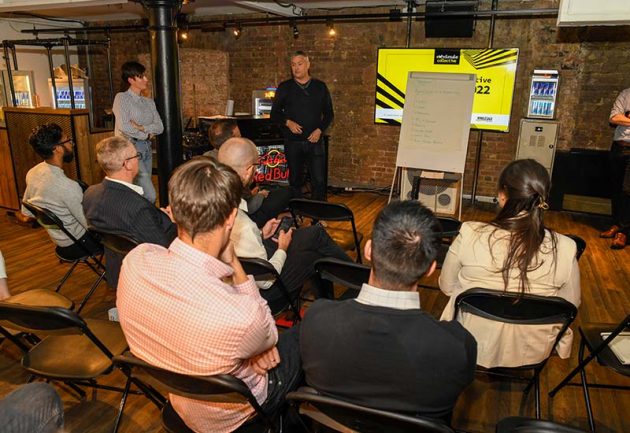
eWholesale Collective tackle industry’s digital challenges
E-commerce experts from across the industry unite to tackle three common issue wholesalers are currently facing in the digital space
It’s been more than two and a half years since the eWholesale Collective first came together to host a day of e-commerce chat and debate and nobody could have predicted what would change in that time.
But as the four supporting brands – PepsiCo, Mars Wrigley, Red Bull and Diageo – welcomed industry e-commerce experts together again, the state of play is significantly different to the end of 2019.
In order to inspire new ideas and work on solutions to help the entire spectrum of wholesalers operating in this space, we set three groups of attendees one of a trio of common e-commerce challenges wholesalers report facing. Each group was given time to work through the tasks before presenting their ideas to the entire collective.
GROUP 1
Lotte Tregear, Red Bull; Phill Jaremczenko-Dye, Mars Wrigley; Johnathan Orchiston, PepsiCo; Marcus Vallance, SalesOut; Aaron Bihal, Time Wholesale Services; David Visick, FWD; Tim Martin-Harvey, Millennium Group; Blonnie Whist, Lumina Intelligence
The scenario
A smaller wholesaler is looking to revamp its e-commerce option and while start-up costs are affordable, the challenge is to resource the maintenance of its new channels and manage orders internally. It needs to find a cost-efficient solution that delivers maximum returns to fully commit to making the change. What basic digital elements can a wholesaler put in place?
The discussion
LOTTE It’s a challenging brief because e-commerce does have a scaling aspect to it. If you’re a really big wholesaler, there are some things that I would have a bit of trepidation over. The first step is the hardest and we did think about what it would be like to be a wholesaler who had no e-commerce presence and deciding, ‘this is it, we’re going to do it’.
There’s a lot to consider, not just the front-end stuff but also how to manage the website and get all the content in, then there’s a whole piece around fulfilment and the impact it has to all your operations as a wholesaler.
PHILL Two of the biggest challenges for a wholesaler setting up on e-commerce are how much things are going to cost and has their team got the capability to run and maintain a site, as well as the other data principles and blind spots they don’t know about because it’s a new space. It shouldn’t be about making digital complex though, it should be simple and about taking them on that journey.
LOTTE We spent a lot of time considering the sell-in to the wholesalers to do it in the first place and we thought about the ‘why’ that sits behind it all. It could easily be the case that in the next five years we see an even greater penetration of retailers moving to shop online, so we talked about the risk factors for not doing it. We then talked about the pull factors of increased loyalty, increased basket size and increased category participation.
PHILL Our recommendation would be to keep it simple. There are many off-the-shelf models that wholesalers can purchase, so they should look for simple models they can plug into existing systems they already have to kick off their online business. A lot of these solutions are quite modular, so they can be simple to begin with, allowing wholesalers to test and build from there.
We believe the cost can be mitigated through lots of different ways, such as by selling media or becoming more focused on shopper experience, or supplying category information to their customer base – it just needs a bit of creativity to find ways to do that.

GROUP 2
Emily Rockingham, Diageo; Mica Bihal, Time Wholesale Services; Mark Jones, AF Blakemore; Holly Franklin, Lumina Intelligence; Mike Chapman, PepsiCo; Matt Pettit, Mars Wrigley; Tom Johnson, Red Bull
The scenario
A traditional wholesaler is concerned about maintaining a strong connection with its customers after launching its e-commerce channels and giving them an alternative to visiting its cash and carry. The wholesaler is concerned about maintaining loyalty and is unsure how to share enough knowledge and getting as much value from its promotions as previously. What tools/techniques are available for the wholesaler to do this?
The discussion
MARK There’s an obvious challenge that when you move out of a bricks-and-mortar environment to one that’s more virtual, you’ve got more of an arms-length relationship with those retailers that you used to be able to walk down the shopfloor and have a conversation with.
Part of the challenge is ensuring your virtual solution isn’t one way, it has to be a two-way conversation. But one of the things that a virtual solution enables you to do is bring that insight in from the customers and use that to create a more personalised relationship.
EMILY The challenge is three-fold. Firstly, it’s about how they continue to drive that sense of community online that exists in depot and the role a wholesaler usually plays there.
The next issue is how to get more loyalty out of their customers without that because shoppers are far more promiscuous than ever before in whatever market, and it’s also true in wholesale. Thirdly, it’s about how wholesalers can continue to get as much value as possible out of promotions and activations online because it’s a really tough place to trade in.
MICA One of the biggest solutions is around personalisation and connecting with the customer. It’s about staying in touch with them on a regular basis, even if you’re used to doing it face to face in the cash and carry. To create that value, you need to personalise communication for what the customer needs, not just what we or the supplier wants to sell.
Everyone has a lot of ideas and it’s just a case of putting everything out on the table and actually working really closely with our suppliers to find out what’s most important for our customers.
Our suppliers have been a big part of us moving forward to where we are at Time Wholesale because they’ve got specialised digital and e-commerce teams, so getting their experience and knowledge has been a massive part of our progression because e-commerce is still fairly new to us. It’s about experimenting and working with them to see what works and what doesn’t.
MARK Solutions like planograms and lots of other value-add activities we can offer on the website are key. My view is that a virtual world that delivers the ease of digital paired with the access it gives to the assortment, range and value opportunities that were previously offered from cash and carry is the way to get it right.
EMILY One of the key things that has come out of the discussions today is how loyalty is really the output of all the tools we’ve talked about. We’ve talked a lot about how wholesalers can better deliver knowledge – information and advice tools in a really tailored and meaningful way – but also how we can go about delivering value in different ways from an operations standpoint, rather than just a race to the bottom on different price points. It’s asking, ‘what are the different things people shopping in this environment would perceive or value over and above core traditional promotions?’.

GROUP 3
Zoe Goncalves, Mars Wrigley; Octavia Prendergast, Red Bull; Claire Chin, Bestway Wholesale; Ravi Kotecha, Drink Supermarket (HT Drinks); Greg Deacon, Jisp; Tanya Pepin, TWC; Kevin Rhodes, PepsiCo
The scenario
A leading wholesaler is looking to take its established e-commerce channels to the next level, after seeing growth figures plateau. The wholesaler has an app and website that follow all the basic principles of a successful channel and have served the business well. What are the key considerations and options available to take the next step online?
The discussion
RAVI When it comes to digital, a lot of wholesalers have been quite slow. One of the key challenges, especially for wholesalers who are established online already, is that some of the more traditional businesses that still have deep pockets are now willing to invest in digital. They’ve realised their own customers are changing habits, are time-poor and moving to more digital methods.
The big challenge when that happens is that when some of the traditional wholesalers go online, there are more players in the market and wholesalers are fighting for the same customers. Their pricing models need to be quite strong as well and equally as competitive.
KEVIN The key thing for a wholesaler to do is understand their customer and drive that customer-centric approach. We need to understand where shoppers are spending time online, how they shop online – whether that’s using search or going to favourites – and really identifying where the focus areas are to drive new growth.
RAVI It’s so important to understand the data that you’re harvesting from different platforms and bundling that in with the market data as well. That will allow you to better understand your customers, their habits and work out ways to offer more of what they’re interested in buying, rather than just putting products in their face.
Part of this is investing in resources that can help you do that. Traditional wholesalers need to bring new types of resources, so instead of warehouse and field sales people, they need analysts and digital marketeers, people who understand social media and direct marketing.
KEVIN The solution we’d suggest starts with understanding their customer, which wholesalers can do by having that location online and scraping the platform to understand where customers are spending their time. Once they have that data, it’s about offering more personalised solutions for customers – whether that’s push notifications, email marketing or just showing different adverts online that appeal to their interests, what they’ve purchased before or different offers.
Categories eWholesale Collective















